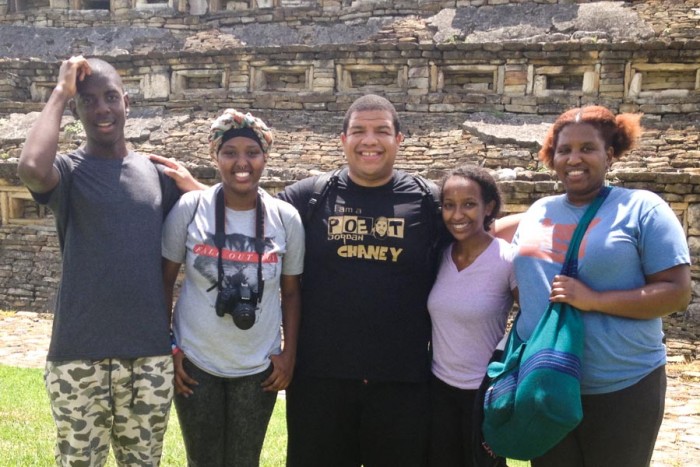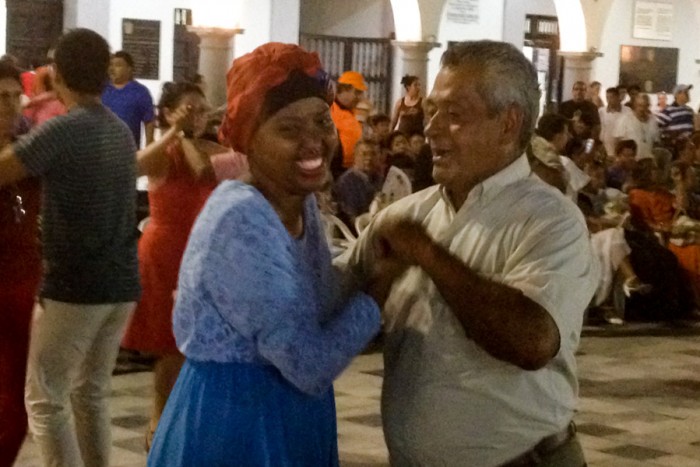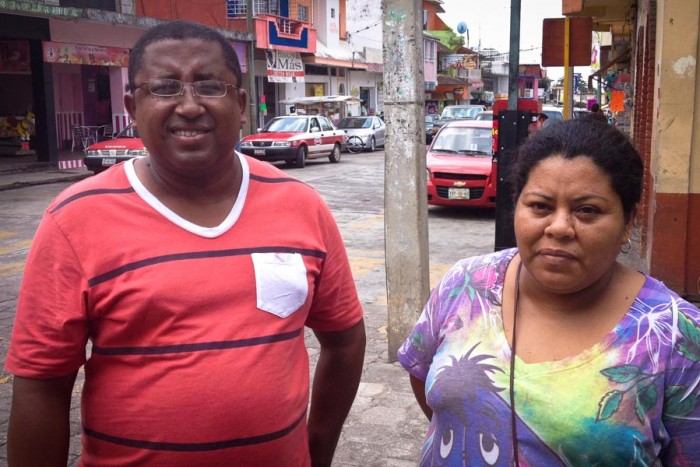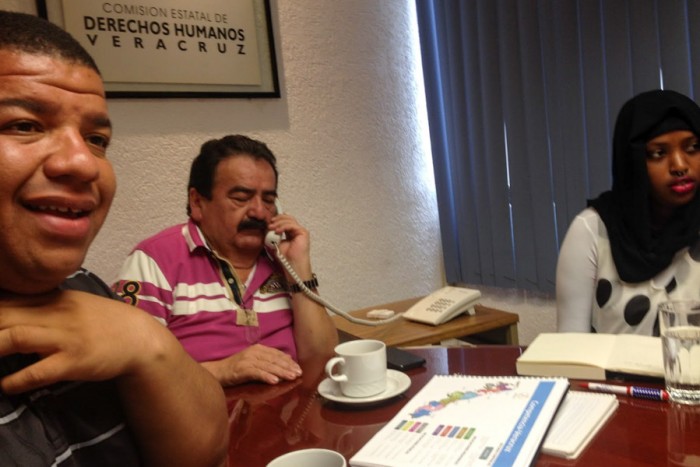
In the shadow of the great white cathedral, I stood on the edges of the Zocalo dance floor watching the couples twirl by in dress whites and fancy shoes. I had been in this exact spot the year before, but this time I saw it through the eyes of the two young women standing beside me.
I watched them absorbing it all, the sway of palm trees against the night sky, the banter of tourists haggling with vendors over lacy peasant blouses and colorful scarves.
And I watched Veracruz watching us, their eyes drawn to our dark skin and African features.
I have led over 200 youth abroad over the course of eight trips with various other program. But this trip was a first for me. It marked the inaugural voyage of my own program Many Voices One Tribe — aimed to empower young writers of color to see the world, to know themselves, and to define their futures.
It was also the only all black group I’ve ever led.
Travel and writing have been the catalyst for my own exploration of my identity as a black woman in the world, and I created this program in hopes of guiding youth through a similar process. And honestly, after this year of tragedies, I looked forward to taking a break from the oppressive race politics of the U.S.
There were just five of us: Jordan Chaney, my adult co-facilitator, and three youth, Azeb, Eyerusalem, and Zion.
When I traveled to Veracruz the year before to make preparations for the program, I went hoping to explore the Black Diaspora in Mexico. I had read about a town called Yanga, known as the “first free town in the Americas” that boasted a rich history and an annual Afro-Mexican carnival. I arrived in Veracruz expected to find a population of Afro-Mexicans, but instead found a fascinating legacy of cultural erasure.
“Cubana? Dominicana?” I played the guess your nationality game daily and despite being fluent in Spanish — and despite the fact that historically there has been a rich African diaspora in Mexico no one ever mistook me for Mexican.
This time with youth in tow I wondered how we would be received.

The staring began as soon as we got off the plane, followed by the picture taking. Wherever we went strangers approached us, sometimes sheepishly, sometimes boldly, and asked to take our pictures. Zion, the tallest and darkest among us was especially popular.
“I feel like a low key Kim Kardashian,” he confessed one afternoon after escaping a 20 person family that had become his own personal paparazzi. We stood surrounded by ancient pyramids in the ruins of Tajin, yet Zion proved to make a more compelling snap shot.
We made jokes about it. When Eyerusalem began the research for an article about standards of beauty for Mexican women and girls, we laughingly turned the tables. We scoured the mall and the Zocalo for teenaged girls willing to be captured digitally. There was a playful reciprocity in these interactions, a mutual exploration of one another’s cultures.
My participants had found the respite I had hoped they would. After the first few days I saw them visibly relax.
Arriving in Mexico didn’t change the fact that we were black, but our cultural context had changed completely. There were no looks of hate or mistrust. When people followed us around in a store it was because they wanted to take our picture or tell us how beautiful our skin was. The Mexican police were formidable with their military uniforms and machine guns. But the youth felt no fear in their presence.
Though Azeb dressed in hijab, in the predominantly Catholic country there seemed to be no context for anti-Muslim prejudice. In fact no one seemed to know much at all about Islam, much less have an opinion.
When the jokes and newness died down, we began to ask the deeper questions. Where were all the black people? Where were the indigenous people? Why were people so enamored and fascinated by us? If we lived there would we still be well treated?

During the pre-departure orientation we spent a morning with Seattle Fandango Project learning a typical song (that Jordan never stopped singing). This ballad about an endangered parrot was played on a ukulele with singing and stomping. Arturo paused to explain the history of the music, stating that the stomping percussion came from the African tradition of drumming. When the Spaniards realized that drumming was a part of African spirituality drums were outlawed, but the slaves realized that they could create similar sounds with their feet. The Native Mexican traditions of music included pan flutes and singing. The Europeans brought with them string instruments like guitars.
I thought often about this explanation of the cultures fused to create what is known as traditional Mexican music, because I saw it replicated in food and customs. While cultural influences were very visible from the Spanish lace worn on the dancers skirts, to the Indigenous names that marked many of the towns, the individual cultures themselves seemed to have disappeared.
In a late night conversation with one of the language school owners, a retired white man from the US, he confessed that to him the way that race was handled in Mexico was the answer, that if people just kept marrying we would all blend until cultural distinctions disappeared. While I understood what he was trying to express it seemed naïve and privileged to believe this could be true.

During our time in Xalapa visiting the human rights commission, we’d heard stories from indigenous and black communities desperate for recognition as a part of Mexico — groups of people who were bullied into learning Spanish in the past, only to later be denied government recognition because they’d lost their own unique language.
The very government who stripped them of their culture through their school policies then is in position to decide how they are able to identify legally. Much like our white government and laws, the very same institutions that once enslaved us black people now tell us what rights and recourse we are legally entitled to in our fight against racism.
Why should I have to be erased in order to be accepted?
Blackness is one of my most visible identities. It’s often the first thing people notice about me. In the States this visibility comes at a price — I am seen as inferior or dangerous. Black youth are disproportionately punished by teachers and shunted through the school to prison pipeline, and as we have all witnessed even something as trivial as being a black kid playing with a toy gun can get you killed.
For those two weeks in Mexico, we were hyper-visible. And through all that undue attention, our blackness was being celebrated. It was humanizing experience to have an old woman touch my arm and whisper “Negra, how beautiful your skin is.”
I don’t agree that the answer is that we all must become the same, but rather that the gaze in the U.S. must change. We must be seen and treated with humanity we deserve.
Want to hear more? Check out the Many Voices One Tribe blog, or stop by our report-back potluck this Saturday, August 15 from 6-8pm at the Hillman City Collaboratory.


I really enjoyed this piece. I have not traveled in Mexico (just passed through on way to other countries in that part of the world) but the history of colonialism is so stark and sad throughout that part of the world. On the one hand, when cultures mix, they will mix — and it is very difficult for people to hold onto what their great great great grandparents did, because we have our own lives to live in the present. On the other hand, there was a concerted effort to erase and destroy people’s cultures, heritage, and history — and replace it with a European culture and history. That pain by itself might be enough to overcome (after all, people are conquered and lands remade throughout recorded history and beyond); the problem is that the oppression and destruction is ongoing. It has not ceased. Even whilst people say “oh let’s all mix in and celebrate” there is denial of resources, theft of resources, and social exclusion.
Thank you for this story. I’ve lived in Mexico for over four years. Yes, there is racism in Mexico, but it is very different from what I’ve experienced in the states. As you note, there is less ingrained anti-black attitudes among the people, but there is still historical and ongoing erasure of black and indigenous communities.
As you certainly know, the great majority of Mexicans are mixed, mestizo. Yet the culture of their precolumbian ancestors is gone, destroyed. When people get together to celebrate their lost native culture, they must borrow from other traditions and sometimes fall into stereotyping. Thus we see “pan-indianism”, where a group of indigenous dancers are costumed like Plains Indians, feathered headdresses and fringed leather vests.
Wonderful story. I am African-American and have lived in the state of Guerrero, Mexico for over 18 years. Our state has one of the highest populations of Afromexicans and the only museum of Afromexican history in Latin America. I can to conduct post-graduate research, but I STAYED because of the difference sense of FREEDOM that I have here. Most do not know that during colonial times, Africans accounted for 70% of the foreign population in New Spain, with Europeans making up 30%. For more information about our state and it’s African culture, visit, http://www.FreedomPathways.org